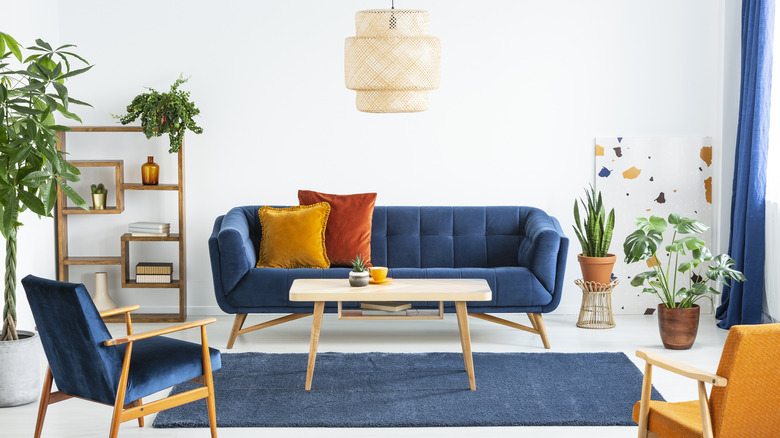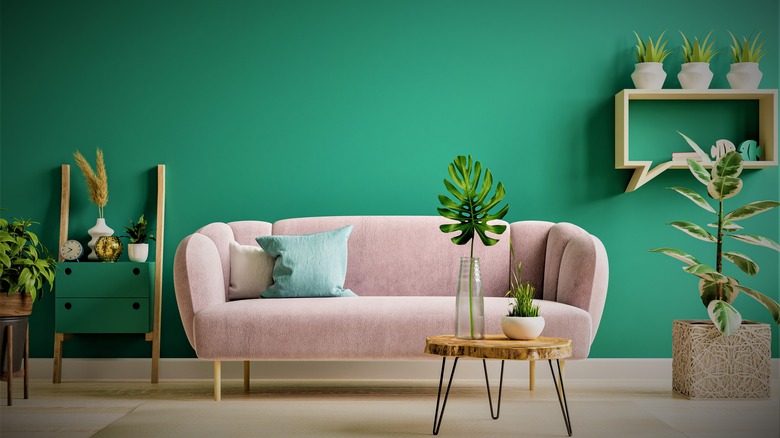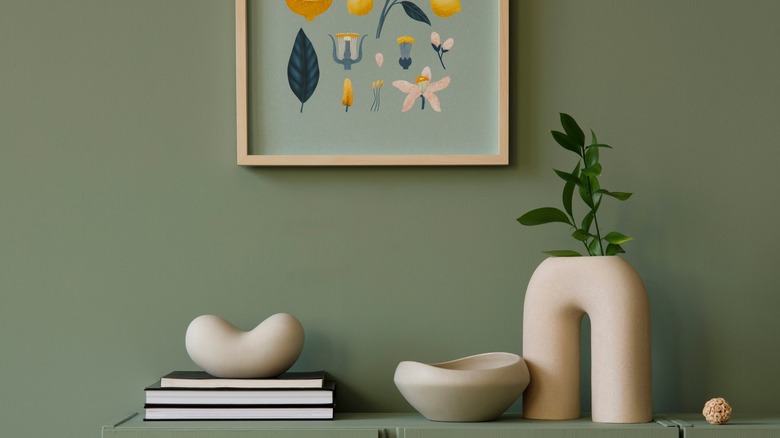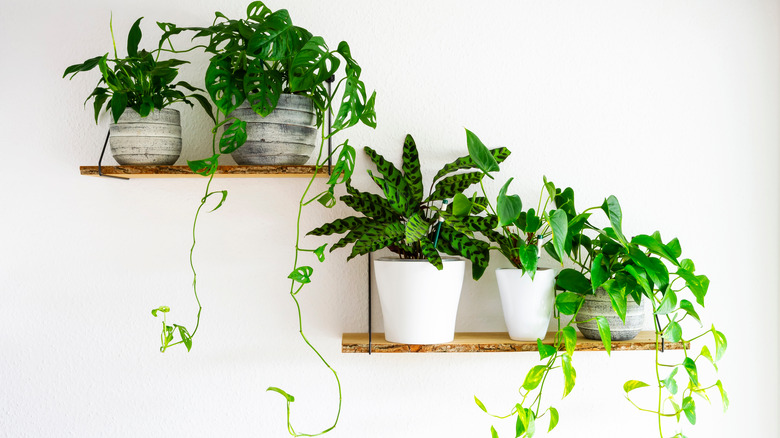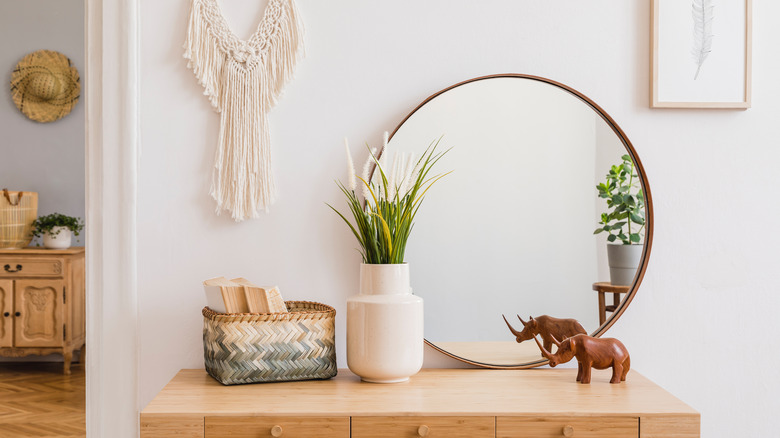Justina Blakeney's Tips For Styling A Maximalist Home
You can identify an interior created by Justina Blakeney by the bold use of color and pattern. The worldly influences and natural elements make the spaces feel exotic yet comfortable. Her style is no doubt maximalist, an interior style that's marked by the use of mixing a variety of colors and textures, says Hommes Studio. While some might see this aesthetic as chaotic, there is actually an art to creating it, making a space that could often be called cohesive chaos.
Justina Blakeney has mastered this balance and has become an inspiration for anyone looking to try the more is more approach to their homes. You can add her designs to your space through her collaborations with stores like Anthropologie and Target. She's also shared her methods for styling a house to the max on the Anthropologie blog. Her tips will help anyone apply the maximalist concept to their personal style.
Consider functionality
Maximalist homes can quickly look like a cluttered mess if you don't approach the concept correctly. That's why Justina Blakeney stresses that functionality is one of the most important aspects of a maximalist space. "That and organization are what really differentiate a maximal home from one that's just cluttered," Justina tells Anthropologie. That means focusing on the basics, like keeping the floors tidy, organizing your table tops, and straightening out your furniture, says Life Storage. Neatening up your space prevents it from looking too chaotic.
Maximalism means you can go bold, but you don't have to take everything to the max. Leave a bit of empty space to create visual breathing room, spaces where your eye can rest. This doesn't necessarily mean using neutrals if you're a fan of color. But think about playing with height and spacing. Pull your coffee table away from the sofa, cluster objects together to create room on a shelf, or use plants to add texture. Visual breathing room will go a long way in making focal points while still showing off all the details.
Contrast is everything
Interiors that are one note are boring and often feel like a showroom rather than a lived-in home. And that's true of any style or color, which is why contrast is key to interior design, including maximalism. Mix up your furniture and decor with items of different sizes and colors, and throw some old in with the new as well. "It's about the mix: These homes mix heirloom pieces with handmade pieces, or with art that the kids made," Blakeney tells Anthropologie. "It's not so much about layering beautiful things as it is layering things that have meaning, then creating compelling contrasts — and drawing connections — between them."
Be cautious about creating a maximalist showroom. You don't want to buy furniture and decor only because they fit the style. As Blakeney suggests, personal touches help make a home feel lived-in. You can purchase custom artwork, says Latter Blum, or buy pieces from small, local artists to juxtapose furniture you might get from a big box store. Display souvenirs from places you've traveled and make a space for your hobbies to show off your personality.
Try new neutrals
Maximalist homes are known for their vivid use of color. It's a direct response to minimalism, which made white, black, and gray the focus of the design. And for many maximalists, the more color, the better. Neutral colors can seem dull compared to lots of colors and patterns. But only using bold design choices can make a room look too busy. The middle ground? Reconsider what's considered neutral. Of course, you can't change the definition, but you can choose a calming shade of a color that can act the way a neutral does in the space.
For Justina Blakeney, that color is sage green. "Like if you could color swatch a succulent," she says of the color to Anthropologie. "It's nature's way of soothing the soul." This can work well because green certainly acts as a neutral in nature, according to LiLu Interiors. Green can be grounding and relaxing, the perfect backdrop if you're looking to create visual rest with colors.
Of course, green isn't right for everyone. But this design tip is more about finding the neutral that works for your personal style. Blakeney's advice is to think about how color and mood connect. "Close your eyes and think of the last few times you can remember feeling really relaxed ... What colors do you see?" Use this as inspiration rather than thinking about what's currently trending.
Bring the outside in
Plants are an incredible tool when it comes to interior design. They add life to your space as well as color and texture. And they're one of Justina Blakeney's favorite ways to connect the spaces she designs with nature. "It became so clear to me at such a young age that plants have the power to transform not only spaces, but people too. Once you're in a rhythm with plants and you're surrounded by them — and they're thriving and you're thriving — forms this beautiful symbiotic relationship," Blakeney tells Anthropologie. If you're new to having plants in your space, start with some that are easy to care for. Snake plants, pothos, spider plants, succulents, and cacti are all great options for beginners, says Stauffers of Kissel Hill. Once you have a good foundation, you can start taking care of more exotic varieties.
But leafy friends aren't the only way to bring nature inside. Blakeney suggests utilizing natural materials in your home as well as plants. Jute, rattan, wicker, and wood are all great options for furniture and decor like rugs and add plenty of texture to the space. Cotton and wool are more natural options that also help to add a softness to a room.
Edit your spaces
While maximalism may seem like a little bit of everything in one place, there is a method to make it look curated, collected, and cohesive. The first step is curating, which means you have to handpick items and collect them over time, says Stone Gable Blog. This requires you to have a discerning eye and some restraint. You can't buy everything, even if it's in your style. Curation is about choosing furniture and decor with intention, which may require you to turn down some things you may love.
The second step is editing your space and as well as your items. It can take being observant of the world around you. Blakeney notes how high paintings hang in museums or what plants sit together at nurseries. She suggests to Anthropologie to "really log those ideas from the experts" to use them back in your home.
It also takes editing the layout of your home. Start by grouping items together by color or by size before going to decorate. "Oftentimes, grouping my belongings in this way helps me see new relationships," the designer tells Anthropologie. "I just start looking at the communication between objects and thinking, 'Oh we need more height here, so I'm going to put a couple books underneath it.'" By grouping your items, you can see if you need more contrast or cohesion, color or texture. And editing is also a great way to ensure your space doesn't become cluttered.

